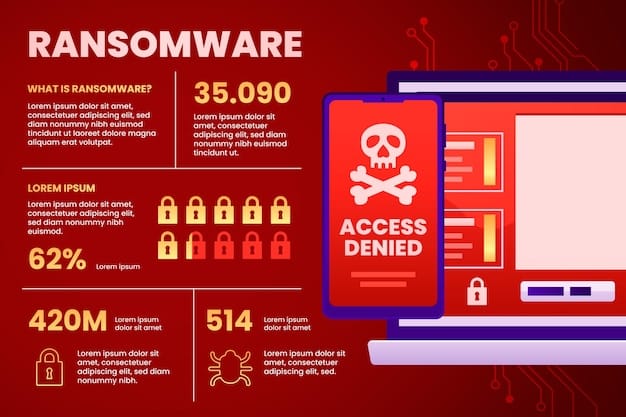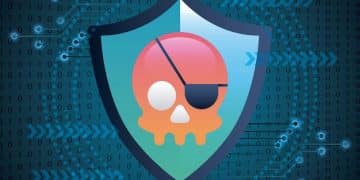Ransomware Attacks: Protect Your Business Data and Finances

Ransomware attacks are a growing cybersecurity threat targeting businesses of all sizes; this article outlines practical steps to protect your business data and finances, including prevention strategies, incident response plans, and employee training.
The landscape of cybersecurity is constantly evolving, and one of the most significant threats facing businesses today is ransomware attacks. These attacks can cripple operations, leading to significant financial losses and reputational damage. Understanding the risks and implementing proactive measures is crucial for survival in today’s digital world.
Understanding the Ransomware Threat Landscape
Ransomware attacks have become increasingly sophisticated and prevalent. It’s essential to understand the various types of ransomware, how they infiltrate systems, and the potential impact they can have on your business.
Types of Ransomware
Different types of ransomware employ various methods to encrypt your data and demand payment. Some common types include:
- Locky: Known for its use of malicious email attachments.
- CryptoLocker: One of the first widespread ransomware variants.
- WannaCry: Gained notoriety for exploiting a vulnerability in Windows systems.
- Ryuk: Targets enterprise environments and demands large ransoms.
How Ransomware Attacks Occur
Ransomware typically infiltrates systems through:
- Phishing emails: Tricking users into clicking malicious links or opening infected attachments.
- Exploiting vulnerabilities: Taking advantage of security flaws in software or operating systems.
- Compromised credentials: Using stolen or weak passwords to gain unauthorized access.
- Malvertising: Spreading malware through online advertisements.
The Impact of Ransomware
The consequences of a ransomware attack can be devastating. Businesses may face:
- Data loss: Inability to access critical files and databases.
- Financial losses: Ransom payments, recovery costs, and lost revenue.
- Reputational damage: Loss of customer trust and negative publicity.
- Operational disruptions: Shutdown of business operations and delays in service delivery.
In conclusion, understanding the ransomware threat landscape is the first step toward protecting your business. By being aware of the different types of ransomware and how they spread, you can better prepare to defend against these attacks.

Implementing Preventative Measures
Prevention is always better than cure when it comes to cybersecurity. Implementing robust preventative measures can significantly reduce your risk of becoming a ransomware victim. These measures include network security, software updates, and access control.
Network Security
Securing your network is crucial for preventing ransomware from spreading. Consider implementing these strategies:
- Firewalls: Use firewalls to monitor and control network traffic.
- Intrusion Detection Systems (IDS): Detect and respond to malicious activity on your network.
- Virtual Private Networks (VPNs): Encrypt data transmitted over the internet to protect sensitive information.
- Network Segmentation: Divide your network into isolated segments to limit the impact of a breach.
Software Updates
Keeping your software up to date is essential for patching vulnerabilities that ransomware can exploit. Ensure that:
- Operating systems: Automatically install updates from Microsoft, Apple, and other vendors.
- Antivirus software: Use a reputable antivirus program and keep its definitions updated.
- Applications: Regularly update third-party applications such as Adobe Reader, Java, and Flash.
Access Control
Limiting access to sensitive data can help prevent ransomware from encrypting critical files. Implement these practices:
- Principle of Least Privilege: Grant users only the minimum level of access they need to perform their job duties.
- Multi-Factor Authentication (MFA): Require users to provide multiple forms of authentication, such as a password and a code from their mobile phone.
- Regular Audits: Conduct regular access control audits to identify and address any potential security gaps.
By implementing these preventative measures, you can create a strong defense against ransomware attacks. A proactive approach to security is essential for protecting your business data and finances.
Developing an Incident Response Plan
Despite your best efforts, a ransomware attack may still occur. Having a well-defined incident response plan can help you quickly contain the attack, minimize damage, and restore your systems. Here’s what to include in your plan:
Detection and Identification
The first step in responding to a ransomware attack is to detect and identify it. Look for:
- Unusual system behavior: Slowdowns, crashes, or unknown processes running.
- Ransom notes: Files with instructions for paying the ransom.
- Encrypted files: Files with unusual extensions that you cannot open.
Containment
Once you’ve identified a ransomware attack, the next step is to contain it. This involves:
- Isolating infected systems: Disconnecting them from the network to prevent the ransomware from spreading.
- Disabling shared drives: Preventing access to shared drives to protect uninfected systems.
- Changing passwords: Resetting passwords for all user accounts to prevent further compromise.
Eradication and Recovery
After containing the attack, you’ll need to eradicate the ransomware and recover your systems. This may involve:
- Removing the ransomware: Using antivirus software or specialized tools to remove the malware from infected systems.
- Restoring from backups: Recovering your data from backups stored in a secure, offsite location.
- Rebuilding systems: Reinstalling operating systems and applications on infected systems.
In conclusion, having a robust incident response plan is crucial for minimizing the impact of a ransomware attack. By quickly detecting, containing, and eradicating the threat, you can reduce the damage and restore your business operations.

Employee Training and Awareness
Your employees are often the first line of defense against ransomware attacks. Training them to recognize and avoid phishing emails and other threats can significantly reduce your risk. Some simple training involves regular security updates and simulated phishing emails.
Recognizing Phishing Emails
Teach your employees to look for these red flags in phishing emails:
- Suspicious sender addresses: Email addresses that don’t match the sender’s organization.
- Poor grammar and spelling: Errors in the email’s text.
- Urgent requests: Demands for immediate action or sensitive information.
- Suspicious links or attachments: Links that lead to unfamiliar websites or attachments with unusual file extensions.
Safe Browsing Practices
Educate your employees about safe browsing habits, such as:
- Avoiding suspicious websites: Not visiting websites that look untrustworthy or have a bad reputation.
- Being cautious when downloading files: Only downloading files from trusted sources.
- Using strong passwords: Creating passwords that are long, complex, and unique.
Regular Security Updates
Keep your employees informed about the latest security threats and best practices. Consider:
- Conducting regular training sessions: Providing ongoing education about ransomware and other cybersecurity threats.
- Sending out security alerts: Informing employees about new threats and how to avoid them.
- Simulating phishing attacks: Testing employees’ ability to recognize and avoid phishing emails.
Employee training and awareness are essential components of a comprehensive cybersecurity strategy. By empowering your employees to recognize and avoid threats, you can significantly reduce your risk of a ransomware attack.
Backing Up Your Data
Data backups are your safety net in the event of a ransomware attack. Without proper backups, you may have no choice but to pay the ransom or lose your data. A robust backup strategy involves following the 3-2-1 rule:
The 3-2-1 Backup Rule
The 3-2-1 backup rule is a best practice for ensuring data protection. It states that you should:
- Have at least three copies of your data: The original data and two backups.
- Store the copies on two different types of media: Such as local hard drives and cloud storage.
- Keep one copy offsite: To protect against physical disasters or local ransomware attacks.
Types of Backups
There are several types of backups you can use, each with its own advantages and disadvantages:
- Full backups: Copy all data every time, providing the most complete protection.
- Incremental backups: Copy only the data that has changed since the last backup, saving time and storage space.
- Differential backups: Copy all the data that has changed since the last full backup, providing a balance between speed and completeness.
Testing Your Backups
It’s essential to test your backups regularly to ensure they are working correctly. This involves:
- Performing test restores: Restoring data from your backups to a test environment to verify that the data is intact.
- Monitoring backup logs: Checking the logs to ensure that backups are completing successfully.
- Updating your backup plan: Keeping your backup plan up to date with your business needs and technology changes.
By implementing a comprehensive backup strategy, you can protect your data from ransomware attacks and other disasters. Regular testing and maintenance are essential to ensure that your backups are reliable and up to date.
Investing in Cybersecurity Insurance
Cybersecurity insurance can help cover the costs associated with a ransomware attack, such as ransom payments, recovery expenses, and legal fees. However, it’s important to understand the terms and conditions of your policy before relying on it.
What Cybersecurity Insurance Covers
Cybersecurity insurance may cover:
- Ransom payments: Reimbursement for ransom payments made to unlock your data.
- Recovery costs: Expenses for restoring your systems and data after an attack.
- Legal fees: Costs for legal representation and compliance with data breach notification laws.
- Business interruption: Compensation for lost revenue due to business disruptions.
Factors to Consider
When choosing a cybersecurity insurance policy, consider:
- Coverage limits: The maximum amount the policy will pay out.
- Deductibles: The amount you’ll have to pay out of pocket before the insurance kicks in.
- Exclusions: Events or circumstances that are not covered by the policy.
- Reputation of the insurance provider: The provider’s track record for paying out claims.
Integrating Insurance with Your Security Strategy
Cybersecurity insurance should be part of a broader security strategy that includes preventative measures, incident response plans, and employee training. It’s not a substitute for good security practices, but it can provide financial protection in the event of a successful attack.
In conclusion, cybersecurity insurance can be a valuable tool for protecting your business data and finances. By understanding the coverage and limitations of your policy, you can make informed decisions about your cybersecurity strategy.
| Key Point | Brief Description |
|---|---|
| 🛡️ Preventative Measures | Implement firewalls, software updates, and access controls. |
| 🚨 Incident Response | Have a plan for detection, containment, and recovery. |
| 🧑🏫 Employee Training | Educate employees to recognize phishing and safe browsing. |
| 💾 Data Backups | Follow the 3-2-1 rule for reliable data backups. |
Frequently Asked Questions (FAQ)
▼
Ransomware is a type of malware that encrypts a victim’s files, making them inaccessible until a ransom is paid. It often targets businesses for financial gain, disrupting operations.
▼
Preventative measures include using firewalls, updating software regularly, implementing access control, and training employees to recognize phishing attempts.
▼
If you suspect an attack, isolate infected systems immediately, disable shared drives, and change passwords. Then, initiate your incident response plan.
▼
Paying the ransom is not recommended, as it encourages further attacks and doesn’t guarantee data recovery. Instead, focus on restoring from backups.
▼
The 3-2-1 rule suggests having three copies of your data, on two different types of media, with one copy stored offsite for maximum protection.
Conclusion
Protecting your business data and finances from ransomware requires a multi-faceted approach. By understanding the threat, implementing preventative measures, developing an incident response plan, and investing in employee training, you can significantly reduce your risk and ensure the continuity of your business operations. Staying informed and proactive is key to navigating the evolving cybersecurity landscape.





